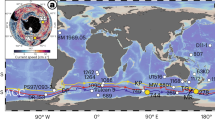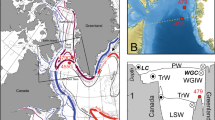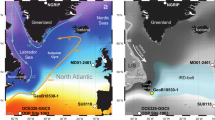Abstract
The Late Cenozoic closure of the seaway between the North andSouth American continents is thought to have caused extensive changes in ocean circulation and Northern Hemisphere climate1,2. But the timing and consequences of the emergence of the Isthmus of Panama, which closed the seaway, remain controversial1,2,3,4,5. Here we present stable-isotope and carbonate sand-fraction records from Caribbean sediments which, when compared to Atlantic and Pacific palaeoceanographic records, indicate that the closure caused a marked reorganization of ocean circulation starting 4.6 million years ago. Shallowing of the seaway intensified the Gulf Stream and introduced warm and saline water masses to high northern latitudes. These changes strengthened deep-water formation in the Labrador Sea over the next million years — as indicated by an increased deep-water ventilation and carbonate preservation in the Caribbean Sea — and favoured early Pliocene warming of the Northern Hemisphere. The evaporative cooling of surface waters during North Atlantic Deep Water formation would have introduced moisture to the Northern Hemisphere. Although the pronounced intensification of Northern Hemisphere glaciation between 3.1 and 2.5 million years ago substantially lagged the full development of North Atlantic Deep Water formation, we propose that the increased atmospheric moisture content was a necessary precondition for ice-sheet growth, which was then triggered by the incremental changes in the Earth's orbital obliquity.
This is a preview of subscription content, access via your institution
Access options
Subscribe to this journal
Receive 51 print issues and online access
$199.00 per year
only $3.90 per issue
Buy this article
- Purchase on Springer Link
- Instant access to full article PDF
Prices may be subject to local taxes which are calculated during checkout


Similar content being viewed by others
References
Keigwin, L. D. Isotope paleoceanography of the Caribbean and east Pacific: role of Panama uplift in late Neogene time. Science 217, 350–353 (1982).
Maier-Reimer, E., Mikolajewicz, U. & Crowley, T. J. Ocean general circulation model sensitivity experiment with an open American Isthmus. Paleoceanography 5, 349–366 (1990).
Duque-Caro, H. Neogene stratigraphy, paleoceanography and paleobiology in northwest South America and the evolution of the Panama Seaway. Palaeogeogr. Palaeoclimatol. Palaeoecol. 77, 203–234 (1990).
Keller, G., Zenker, C. E. & Stone, S. M. Late Neogene history of the Pacific-Caribbean gateway. J. S. Am. Earth Sci. 2, 73–108 (1989).
Collins, L. S., Coates, A. G., Berggren, W. A., Aubry, M.-P. & Zhang, J. The late Miocene Panama isthmian strait. Geology 24, 687–690 (1996).
Shackleton, N. J., Hall, M. & Pate, D. Pliocene stable isotope stratigraphy of Site 846. Proc. ODP Sci. Res. 138, 337–357 (1995).
Coates, A. G. et al. Closure of the Isthmus of Panama: The near-shore marine record of Costa Rica and western Panama. Geol. Soc. Am. Bull. 104, 814–828 (1992).
Marshall, L. G. Land mammals and the Great American Interchange. Am. Sci. 76, 380–388 (1988).
Hay, W. W. Tectonics and climate. Geol. Rundsch. 85, 409–437 (1996).
Oppo, D. W. et al. Aδ13C record of Upper North Atlantic Deep Water during the past 2.6 million years. Paleoceanography 10, 372–394 (1995).
Driscoll, N. W. & Diebold, J. B. Tectonic and stratigraphic development of the eastern Caribbean: New constraints from multichannel seismic data.In Caribbean Sedimentary Basins (ed. Mann, P.) (Elsevier Spec. Publ., in the press).
McCorkle, D. C. & Keigwin, L. D. Depth profiles of δ13C in bottom water and core top C. wuellerstorfi on the Ontong Java Plateau and Emperor Seamounts. Paleoceanography 9, 197–208 (1994).
Kroopnick, P. M. The distribution of 13C of ΣCO2in the world ocean. Deep-Sea Res. 32, 57–84 (1985).
Bickert, T., Cordes, R. & Wefer, G. Late Pliocene to mid-Pleistocene (2.6–1.0 Ma) carbonate dissolution in the western equatorial Atlantic: Results of ODP Leg 154, Ceara Rise. Proc. ODP Sci. Res. 154((1994)).
Tiedemann, R., Sarnthein, M. & Shackleton, N. J. Astronomic timescale for the Pliocene Atlantic δ18O and dust flux records of ODP Site 659. Paleoceanography 9, 619–638 (1994).
Hodell, D. A., Müller, D. W., Ciesielski, P. F. & Mead, G. A. Synthesis of oxygen and carbon isotopic results from Site 704: Implications for major climatic-geochemical transitions during the late Neogene. Proc. ODP Sci. Res. 114, 475–480 (1991).
Shackleton, N. J. & Hall, M. A. Oxygen and carbon isotope stratigraphy of DSDP Hole 552A: Pliocene-Pleistocene glacial history. Init. Rep. DSDP 81, 599–610 (1984).
Ruddiman, W. F. et al. Proc. ODP Init. Rep. 108((1988)).
Tiedemann, R. & Franz, S. O. Deep-water circulation, chemistry, and terrigenous sediment supply in the equatorial Atlantic during the Pliocene, 3.3–2.6 Ma and 5–4.5 Ma. Proc. ODP Sci. Res. 154, 299–318 (1997).
Boyle, E. A. & Keigwin, L. D. North Atlantic thermohaline circulation during the past 20,000 years linked to high-latitude surface temperature. Nature 330, 35–40 (1987).
Heinze, C. & Crowley, T. J. Sedimentary response to ocean gateway circulation changes. Paleoceanography 12, 742–754 (1997).
Wright, J. D. & Miller, K. G. Control of North Atlantic Deep Water circulation by the Greenland-Scotland Ridge. Paleoceanography 11, 157–171 (1996).
Mikolajewicz, U. & Crowley, T. J. Response of a coupled ocean/energy balance model to restricted flow through the central American Isthmus. Paleoceanography 12, 429–441 (1997).
Arthur, M. A. et al. Seismic stratigraphy and history of deep circulation and sediment drift development in Baffin Bay and the Labrador Sea. Proc. ODP Sci. Res. 105, 957–989 (1989).
Shackleton, N. J. et al. Oxygen isotope calibration of the onset of ice-rafting and history of glaciation in the North Atlantic region. Nature 307, 620–623 (1984).
Miller, K. G., Fairbanks, R. G. & Mountain, G. S. Tertiary oxygen isotope synthesis, sea level history, and continental margin erosion. Paleoceanography 2, 1–19 (1987).
Raymo, M. E. & Ruddiman, W. F. Tectonic forcing of late Cenozoic climate. Nature 359, 117–122 (1992).
France-Lanord, C. & Derry, L. A. Organic carbon burial forcing of the carbon cycle from Himalayan erosion. Nature 390, 65–67 (1997).
Myhre, A. M. et al. Proc. ODP Init. Rep. 151, 1–926 (1996).
Imbrie, J. et al. On the structure and origin of major glaciation cycles, 1. linear responses to Milankovitch forcing. Paleoceanography 7, 701–738 (1992).
Laskar, J., Joutel, F. & Boudin, F. Orbital, precessional, and insolation quantities for the Earth from −20 Myr to +10 Myr. Astron. Astrophys. 270, 522–533 (1993).
Li, X. S. et al. Simulating late Pliocene Northern Hemisphere climate with the LLN 2-D model. Geophys. Res. Lett. (in the press).
Billups, K., Ravelo, A. C. & Zachos, J. C. Early Pliocene deep-water circulation: Stable isotope evidence for enhanced northern component deep water. Proc. ODP Sci. Res. 154, 319–330 (1997).
Sigurdsson, H. et al. Proc. ODP Init. Rep. 165, 1–674 (1997).
Acknowledgements
We thank R. Zahn, S. Franz, L. Keigwin, D. Oppo, N. Driscoll, R. Norris, J. McManus and T. Bickert for discussions and criticism, and S. Hustedt and A. Richter for technical assistance. This work was supported by the Deutsche Forschungsgemeinschaft (DFG).
Author information
Authors and Affiliations
Corresponding author
Rights and permissions
About this article
Cite this article
Haug, G., Tiedemann, R. Effect of the formation of the Isthmus of Panama on Atlantic Ocean thermohaline circulation. Nature 393, 673–676 (1998). https://doi.org/10.1038/31447
Received:
Accepted:
Issue Date:
DOI: https://doi.org/10.1038/31447
This article is cited by
-
Rapid strengthening of westerlies accompanied intensification of Northern Hemisphere glaciation
Nature Communications (2023)
-
Global phylogeography of ridley sea turtles (Lepidochelys spp.): evolution, demography, connectivity, and conservation
Conservation Genetics (2022)
-
Mediterranean heat injection to the North Atlantic delayed the intensification of Northern Hemisphere glaciations
Communications Earth & Environment (2021)
-
Central Asian modulation of Northern Hemisphere moisture transfer over the Late Cenozoic
Communications Earth & Environment (2021)
-
Late Pliocene to early Pleistocene climate dynamics in western North America based on a new pollen record from paleo-Lake Idaho
Palaeobiodiversity and Palaeoenvironments (2021)
Comments
By submitting a comment you agree to abide by our Terms and Community Guidelines. If you find something abusive or that does not comply with our terms or guidelines please flag it as inappropriate.




